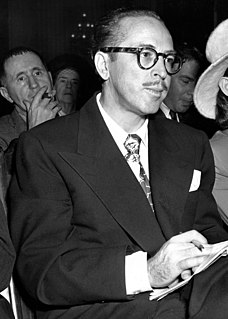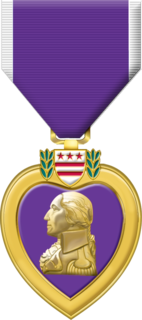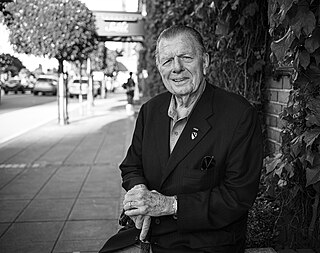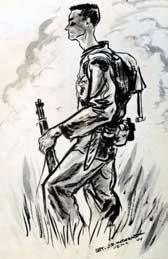Related Research Articles
The Bronze Star Medal (BSM) is a United States Armed Forces decoration awarded to members of the United States Armed Forces for either heroic achievement, heroic service, meritorious achievement, or meritorious service in a combat zone.

James Dalton Trumbo was an American screenwriter and novelist who scripted many award-winning films, including Roman Holiday (1953), Exodus, Spartacus, and Thirty Seconds Over Tokyo (1944). One of the Hollywood Ten, he refused to testify before the House Un-American Activities Committee (HUAC) in 1947 during the committee's investigation of Communist influences in the motion picture industry.

Johnny Got His Gun is an anti-war novel written in 1938 by American novelist Dalton Trumbo and published in September 1939 by J. B. Lippincott. The novel won one of the early National Book Awards: the Most Original Book of 1939. A 1971 film adaptation was written for the screen and directed by Trumbo himself.

The Purple Heart (PH) is a United States military decoration awarded in the name of the President to those wounded or killed while serving, on or after April 5, 1917, with the U.S. military. With its forerunner, the Badge of Military Merit, which took the form of a heart made of purple cloth, the Purple Heart is the oldest military award still given to U.S. military members – the only earlier award being the obsolete Fidelity Medallion. The National Purple Heart Hall of Honor is located in New Windsor, New York.

James Terry Conway is a retired United States Marine Corps four-star general who served as the 34th Commandant of the Marine Corps. Among his previous postings were Director of Operations (J-3) on the Joint Chiefs of Staff, Commanding General of 1st Marine Division and I Marine Expeditionary Force, taking part in the 2003 invasion of Iraq and the First Battle of Fallujah.

Anthony Joseph Drexel Biddle Sr. (1874–1948) was a millionaire whose fortune allowed him to pursue theatricals, self-published writing, athletics, and Christianity on a full-time basis.

Jarhead is a 2005 American biographical war drama film based on U.S. Marine Anthony Swofford's 2003 memoir of the same name. The film was directed by Sam Mendes, starring Jake Gyllenhaal as Swofford with Jamie Foxx, Peter Sarsgaard, Lucas Black, and Chris Cooper. Jarhead chronicles Swofford's life story and his military service in the Gulf War.

The Regimental Combat Team 31 (RCT-31), commonly referred to as Task Force Faith of the "Chosin Few", is a United States Army unit known for its role in the Battle of Chosin Reservoir during the Korean War where 90-95% of its force was killed, wounded, and/or captured on the eastern side of the reservoir.

Joseph Lee Galloway is an American newspaper correspondent and columnist. Since 2013, he has worked as a special consultant for the Vietnam War 50th anniversary Commemoration project run out of the Office of the Secretary of Defense and has also served as consultant to Ken Burns' production of a documentary history of the Vietnam War broadcast in the fall of 2017 by PBS. He is also the former Military Affairs consultant for the Knight-Ridder chain of newspapers and was a columnist with McClatchy Newspapers.

Johnny Got His Gun is a 1971 American drama anti-war film written and directed by Dalton Trumbo based on his 1939 novel of the same name, and starring Timothy Bottoms, Kathy Fields, Marsha Hunt, Jason Robards, Donald Sutherland and Diane Varsi. It was based on the novel of the same title by Trumbo, and features an uncredited writing collaboration by Luis Buñuel.
Hispanics in the United States Marine Corps, such as Private France Silva who during the Boxer Rebellion became the first Marine of the thirteen Marines of Hispanic descent to be awarded the Medal of Honor, and Private First Class Guy Gabaldon who is credited with capturing over 1,000 enemy soldiers and civilians during World War II, have distinguished themselves in combat. Hispanics have participated as members of the United States Marine Corps in the Boxer Rebellion, World War I, the American intervention in Latin America also known as the Banana Wars, World War II, the Korean War, the Vietnam War, the Gulf War and most recently in the military campaigns of Afghanistan and Iraq.

Lieutenant General Leslie Eugene Brown was a United States Marine Corps aviator who served in combat in World War II, the Korean War and the Vietnam War. As a combat pilot, he achieved many aviation "firsts". He retired from the Marine Corps in 1978 after 38 years of active duty service.

The Battle of Shewan was a military engagement between Coalition forces and Taliban insurgents that took place on August 8, 2008, near the village of Shewan in Farah Province, Afghanistan.

Gassed is a very large oil painting completed in March 1919 by John Singer Sargent. It depicts the aftermath of a mustard gas attack during the First World War, with a line of wounded soldiers walking towards a dressing station. Sargent was commissioned by the British War Memorials Committee to document the war and visited the Western Front in July 1918 spending time with the Guards Division near Arras, and then with the American Expeditionary Forces near Ypres. The painting was finished in March 1919 and voted picture of the year by the Royal Academy of Arts in 1919. It is now held by the Imperial War Museum. It visited the US in 1999 for a series of retrospective exhibitions, and then from 2016 to 2018 for exhibitions commemorating the centenary of the First World War.
The United States Army Art Program or U.S. Army Combat Art Program is a program brought about by the U.S. Army to create artwork documenting its involvements in war and peacetime engagements. The art collection associated with the program is held by the U.S. Army Center of Military History. The United States Army Centre of Military History built the National Museum of the United States Army at Fort Belvoir that is now completed and will open when conditions allow.
American official war artists have been part of the American military since 1917. Artists are unlike the objective camera lens which records only a single instant and no more. The war artist captures instantaneous action and conflates earlier moments of the same scene within one compelling image.
"We're not here to do poster art or recruiting posters... What we are sent to do is to go to the experience, see what is really there and document it—as artists."

Kristopher J. Battles is an American artist, known as the last remaining USMC combat artist in 2010.

John McDermott, also known under the pen name J.M. Ryan, was an American illustrator and author noted for action and adventure illustrations. McDermott worked as an in-between and effects animator for Walt Disney Studios and as a US Marine combat artist, before establishing himself as a cover illustrator for 1950s paperbacks and pulp magazines such as Argosy, American Weekly, and Outdoor Life. Under his J.M. Ryan pen name, he wrote the novels The Rat Factory (1971), a derogatory satire of Walt Disney and the Disney studio; Brooks Wilson Ltd (1967), on which the 1970 film Loving was based; and "Mother's Day" (1969) about Ma Barker. Under his own name, he novelized director-writer Bo Widerberg's screenplay for the 1971 film Joe Hill, which would be his final published book.
Victor Juhasz is an American artist.
Michael D. Fay is a former United States Marine Corps combat artist. Before his retirement from the Corps, he was a war artist serving in Iraq. He was deployed as an artist-correspondent embedded with US troops in Afghanistan. He resides in Fredericksburg, Virginia.
References
- ↑ Kino, Carol (May 25, 2012). "Portraits of Wat". The New York Times . Retrieved November 29, 2013.
The artists were at Walter Reed representing the Joe Bonham Project, a year-and-a-half-old group dedicated to documenting the experiences of wounded service members. The group — named for the limbless, faceless protagonist of “Johnny Got His Gun,” Dalton Trumbo’s 1939 antiwar novel— was founded by Michael D. Fay, a former Marine Corps combat artist...
- ↑ "'Reportager' : Members : Mike Fay : Research Group and Programme at the School of Creative Arts, University of the West of England". University of the West of England . Retrieved 29 November 2013.
Michael D. Fay and was the official combat artist for the United States Marine Corps from 2000-2010. In this capacity he completed four combat tours as a war artist, two each in Iraq and Afghanistan, for the National Museum of the Marine Corps. In 2010 Mike retired and, among other things, founded The Joe Bonham Project. The JBP is a reportage art program documenting the faces and experiences of profoundly battle wounded soldiers and Marines.
- ↑ Gammage, Jeff. "Drexel University's Joe Bonham project highlights human cost of war". Philadelphia Media Network . Retrieved 29 November 2013.
Fay says this project is apolitical, aiming to honor the men who fought for their country and support them as they heal. And to show people - if they want to truly see - the reality of war. "We don't want to face the actual aftermath and results of war," said Karen Curry, who teaches the Drexel course Imaging War. "It's messy. It's forever. It's something that people have averted their eyes from."
- ↑ Panero, James (9 September 2011). "Introducing The Joe Bonham Project". The New Criterion. Retrieved 29 November 2013.
Through portraiture, artists from both military and civilian life now work to ensure that today’s soldiers do not become tomorrow’s Joe Bonhams. As the curator of The Joe Bonham Project now on view at Storefront Gallery in Bushwick, Brooklyn, I am pleased to connect these artists with New York's most vital artistic neighborhood.
- ↑ Roffino, Sara (4 November 2013). "Aftereffects of War: The Joe Bonham Project Documents Wounded Soldiers' Recovery". BLOUIN ARTINFO. Retrieved 29 November 2013.
Regardless of its military roots, the Joe Bonham project is witness art, not political propaganda. “We do it to tell the stories. We don’t take a political stance. We’re not heralding the war. We’re not denouncing the war. We’re simply painting a visual picture of those fighting their own wars when they come home,” explained Robert Bates, the Marine Corps veteran and combat artist organizing the group’s upcoming exhibition.